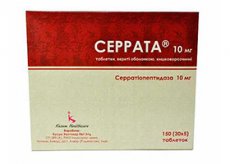Medical expert of the article
New publications
Preparations
Serrata
Last reviewed: 04.07.2025

All iLive content is medically reviewed or fact checked to ensure as much factual accuracy as possible.
We have strict sourcing guidelines and only link to reputable media sites, academic research institutions and, whenever possible, medically peer reviewed studies. Note that the numbers in parentheses ([1], [2], etc.) are clickable links to these studies.
If you feel that any of our content is inaccurate, out-of-date, or otherwise questionable, please select it and press Ctrl + Enter.

Serrata contains the element serratiopeptidase, which is an enzyme extracted from a non-pathogenic intestinal microbe – Serratia type E15; this microorganism has proteolytic properties.
The specified category of bacteria can break down fibrin with bradykinin, as well as other inflammatory conductors. Along with this, it has an anti-inflammatory and anti-edematous effect and demonstrates an analgesic effect - releasing pain amines from inflamed tissues.
Indications Serrata
The versatile medicinal activity of the drug leads to its use in a variety of diseases from different fields of medicine.
Surgery and traumatology: fractures with dislocations, ligament sprains and other injuries. In addition, swelling of various origins (also occurring after operations). As a preventive element, it is used to prevent rejection of a transplanted organ.
Dermatology: acute dermatoses that occur with the development of pain.
Plastic surgery: strengthening microcirculation processes to prevent transplant rejection, as well as reducing swelling after operations.
ENT organs: otitis with sinusitis and other inflammatory diseases (including URT), in which increased mucus formation and problems with sputum discharge are observed. In addition, it is used to improve the absorption of antibiotics.
Gynecology: elimination of swelling of the mammary glands, which appears due to various pathologies, and at the same time to increase the rate of resorption of hematomas (for example, in the case of mastitis).
Pharmacodynamics
Serrata demonstrates a high level of penetration into areas affected by inflammation, and at the same time lyses necrotic tissues with their metabolic elements, reduces hyperemia and acts as a catalyst for the absorption and activity of antibiotics. In addition, the drug helps to liquefy nasal secretions and reduces salivary viscosity, making the process of their elimination easier.
Serratiopeptidase together with blood α-2-macroglobulins create an active complex in a 1:1 ratio, due to which the enzyme's antigenicity is masked without losing its therapeutic effect. Subsequently, blood values of serratiopeptidase decrease, because in the inflammation zone the enzyme passes into exudate.
The breakdown of histamine and serotonin with bradykinin leads to a decrease in capillary dilation and strengthens the strength of capillaries. The drug suppresses elements that block plasmin, which leads to an improvement in its fibrinolytic effect. Reducing edema and weakening microcirculation helps improve the process of sputum discharge.
Pharmacokinetics
The active component and additional elements of the drug are covered with a special enteric coating, which prevents the destruction of tablets in the stomach. As a result, absorption occurs inside the intestine. In the blood plasma, the Cmax indicator is recorded after 1 hour from the moment of use. A small part of the drug is excreted in the urine.
Dosing and administration
The tablets must be taken orally - 30 mg of the drug per day (1 tablet containing 10 mg of the active element, 3 times per day). Food intake does not affect the absorption and therapeutic effectiveness of the drug. The tablet is swallowed whole, without chewing (so as not to damage its enteric coating), and washed down with plain water.
Various pathologies and their varying degrees of intensity may require a change in the daily dose of the medication. The minimum effective dosage, as well as the duration of use, should be selected by the attending physician, taking into account the clinical picture observed in the patient.
Use Serrata during pregnancy
During pregnancy or breastfeeding, Serrata can be prescribed only in exceptional situations.
Side effects Serrata
Serrata use may occasionally cause gastrointestinal pain, nausea, bowel upset, and vomiting.
People who are prone to bleeding may experience increased nosebleeds or blood in their sputum.
There are also reports of the development of signs of allergy - in the form of a rash on the epidermis, itching and hives.
Interactions with other drugs
It has been found that when combined with Serrata, the medicinal activity of anticoagulants is potentiated. If there is a need for simultaneous use of drugs, the patient should be under the supervision of experienced doctors who will, if necessary, adjust the dosage of the anticoagulant.
Application for children
It is prohibited to use the medication in pediatrics (under 18 years of age), because its effect on the child's body has not been fully determined.
Analogues
Analogues of the drug are Movinaza and Fibrinase.
 [ 37 ], [ 38 ], [ 39 ], [ 40 ], [ 41 ]
[ 37 ], [ 38 ], [ 39 ], [ 40 ], [ 41 ]
Reviews
Serrata receives good reviews from patients who used the drug for surgical, gynecological, traumatological and inflammatory conditions - it often worked quite effectively. Use in combination with antibiotics allows to shorten the period of illness and accelerate the processes of weakening the manifestations of pathology, which is also reported in the comments on the forums.
Attention!
To simplify the perception of information, this instruction for use of the drug "Serrata" translated and presented in a special form on the basis of the official instructions for medical use of the drug. Before use read the annotation that came directly to medicines.
Description provided for informational purposes and is not a guide to self-healing. The need for this drug, the purpose of the treatment regimen, methods and dose of the drug is determined solely by the attending physician. Self-medication is dangerous for your health.

